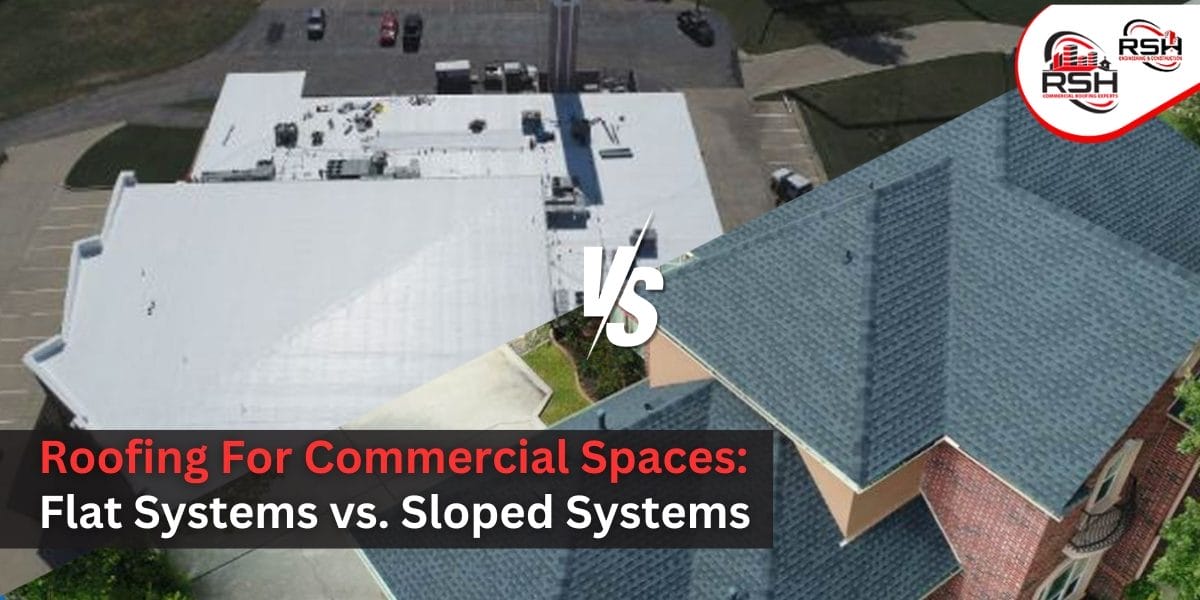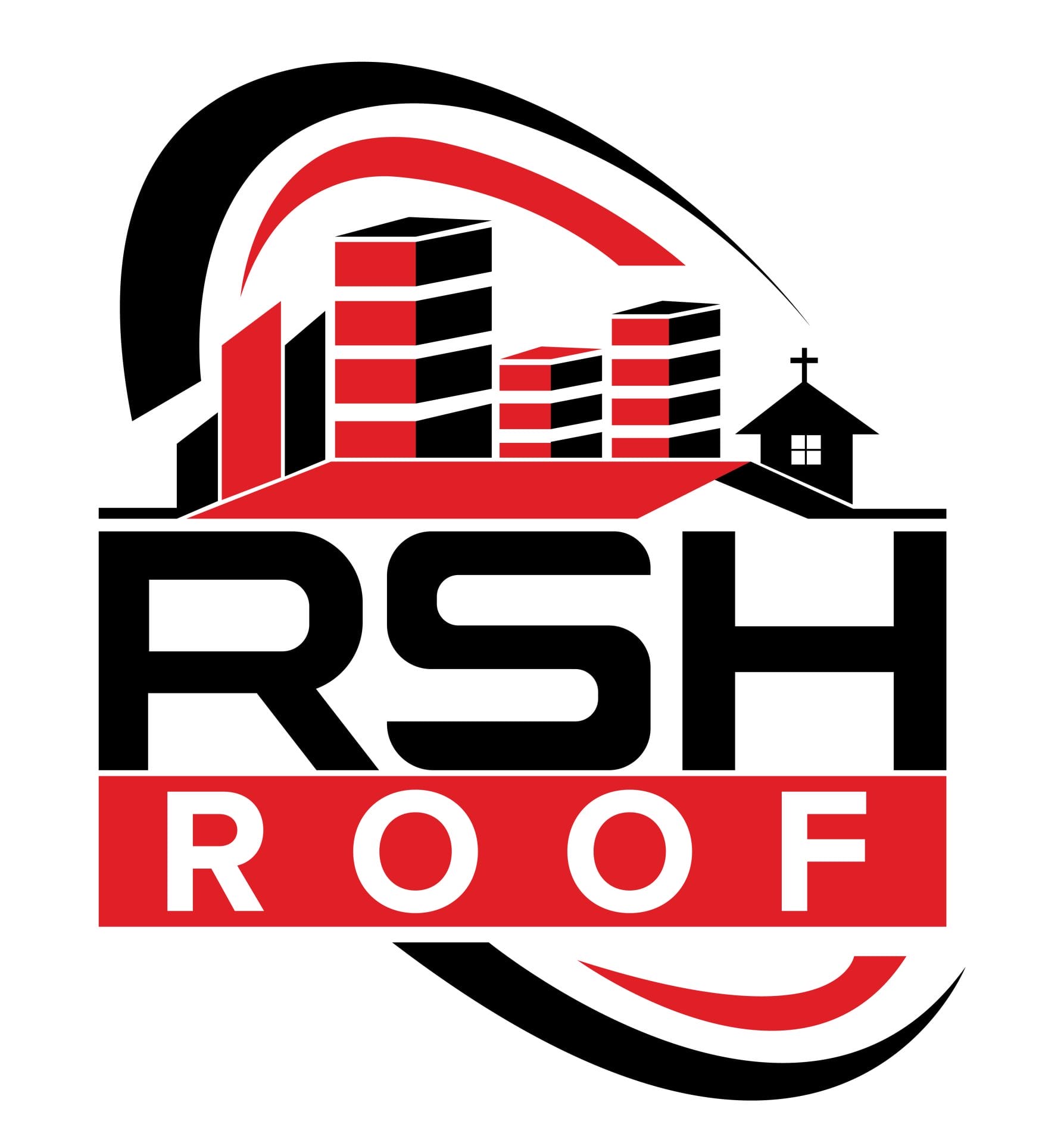RSH Commercial Roofing is a Professional Engineering & Construction Company with 25+ years of experience that specializes in Commercial & Residential Roof Inspections, Repair/Replacement services as well as commercial roofing insurance claims.

Roofing For Commercial Spaces: Flat Systems vs. Sloped Systems
When it comes to maintaining commercial roofing systems, picking the suited systems between, flat systems vs. sloped systems creates their impact significantly for performance, aesthetics, and needs of the building.
With the proper understanding of the different types of commercial roofs, their benefits, and drawbacks is essential to make an informed decision. Therefore, this blog over “Roofing for Commercial Spaces” helps you to explore different options of flat systems vs. sloped systems, and their factors to consider for commercial roof repairs and installations. Let’s dive!
Types of commercial roofs: Flat systems vs sloped systems
Differentiate between flat systems vs. sloped systems, make you understand which roofing system is good to install over your property.
Flat roofing systems:
Flat roofing systems are a great choice for any commercial buildings due to their affordability and practical benefits. As the name says “Flat” it is not actually completely flat, it has a slight pitch allowing for water drainage.
Types of flat roofing system:
Built-up Roofing (BUR):
- Built-up roofing is made up of multiple layers of bitumen and reinforcing fabrics.
- Offers excellent features of protection and durability.
Modified bitumen:
- Modified bitumen is similar to the BUR roofing system, the only difference is it is made up of polymer-modified layers that adds flexibility.
- This roofing system is easier to install and repair.
Single ply membrane:
- Single ply membrane includes TPO, PVC, and EPDM roofs.
- These are lightweight and easy to install.
- Good productivity for UV resistance and energy efficiency.
Sloped roofing systems:
Sloped roofing systems are characterized by their steep pitch, allowing for efficient water and snow runoff. These systems are often smaller for commercial buildings or those with specific architectural designs.
Types of sloped roofing systems:
Asphalt shingles:
- Asphalt shingles are cost-effective and available in varieties.
- The advantage of using this roofing system is easy to install and replace.
Metal roofing:
- Metal roofing is highly durable and therefore long-lasting.
- Less heat consumption, therefore reflects heats, and reduces the cooling costs.
Tile roofing:
- Aesthetic appeal with options like clay, concrete, and slate.
- Tile roofings are heavy to install but very durable and fire-resistant.
Commercial roofing installation: Considerations!
When planning for commercial roof installation, it is crucial to get to know about the pros and cons of both flat systems vs. sloped systems.
Benefits of flat roofing systems:
Cost-effective:
- Flat roofs are costless to install on the commercial roofing than sloped roofs.
- Less labor and machines are required.
Space utilization:
- Requires HVAC systems, solar panels, and green roofs for the installation.
- Serves additional usable space.
Maintenance:
- Flat roofing types systems are easy and safe to access for inspections and commercial roof repairs.
- These flat roofs are simpler drainage systems.
Benefits of sloped roofing systems:
Efficient water drainage:
- Sloped roofing systems have steep slopes used to prevent water accumulation, and help to reduce the risk of leaks.
- Good for snowy areas and to easily erase dirt from the debris.
Longevity:
- These sloped roofs tend to have a longer lifespan due to better water management.
- Materials like metal and tile are exceptionally durable.
Aesthetic appeal:
- This point provides a traditional and attractive look.
- Give an add to the architectural interest to the building.
Commercial roof life expectancy
The commercial roof life expectancy depends on the type of roofing system and material used.
Flat roof life expectancy:
- Built-Up roofing: Retains for 15-30 years
- Modified bitumen: For 10-20 years
- Single-Ply membrane (TPO, PVC, EPDM): 20-30 years
Sloped roof life expectancy:
- Asphalt shingles: 15-30 years
- Metal roofing: 40-70 years
- Tile roofing: 50-100 years
Commercial roof repairs
Both flat and sloped commercial roofing systems needs proper regular maintenance process and occasional repairs for the longevity:
Flat roof repairs:
- Ensure there is a proper drainage to avoid still-positioned water.
- Fixing damages, tears or punctures in single-ply membranes.
- Repair or replace the defacements flashing to prevent leaks.
Sloped roof repairs:
- Placing damage or missing shingles.
- Give a proper roof maintenance from rust, corrosion, or loose panels.
- Replace the broken or cracked tiles.
How to choose a right flat roof specialist or roof contractor?
Selecting the right roof contractors or flat roof specialists is critical to have a successful commercial roof installation and maintenance. Here are some tips:
- Pick a contractor who has extensive experience in the field of commercial roofing system.
- Always look for testimonials and some references from past climates.
- Ensure the contractor has licensed and certified the roofing system you need.
- Check out the warranty period of the work and materials.
Conclusion
Stuck to choose the right roofing system between flat systems vs. sloped systems for your commercial roofing building? Yes! Be careful about the following factors, including cost, maintenance, and life expectancy.
For a successful commercial roof installation, get a professional contractor, or can book an appointment at RSH Commercial Roofing Experts, to get a commercial roofing system for your building.
Don’t wait and get your roof safe today!

